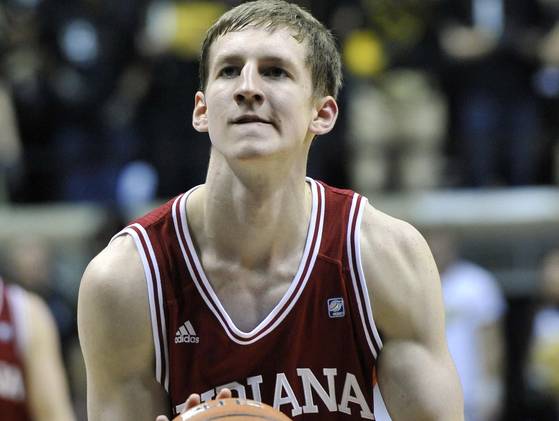Can Cody Zeller Continue to Stay Out of Foul Trouble?
Posted by Deepak Jayanti on February 26th, 2013Deepak is a writer for the Big Ten microsite of Rush The Court. Follow him on Twitter for more about B1G hoops at @dee_b1g.
After 27 games which include just three losses, you begin to wonder if the Hoosiers have any glaring weaknesses that can be exploited during the postseason. At the beginning of the year, especially after Derek Elston’s injury, I wasn’t sure if they would have enough interior depth to beat elite teams in case Cody Zeller picked up a couple of quick fouls in the first half. Because if Zeller is forced to sit, Tom Crean would would have to go with a smaller lineup of Christian Watford, Will Sheehey or (gulp) freshman Hanner Perea in the frontcourt. Although Watford and Sheehey are capable of defending a 6’8” power forward, they wouldn’t be as effective on the offensive end if forced to exert so much energy on defense. But looking back at the Hoosiers’ season so far, Zeller has somehow managed to stay out of foul trouble, a very impressive feat considering that the Hoosiers have already played Minnesota and Michigan State. He has picked up four fouls in just three games: against Jacksonville, Penn State, and Georgetown. Opposing coaches can clearly see that with Zeller on the bench, the inside is open, but they haven’t yet succeeded in exploiting that weakness. Let’s examine how he has managed to stay out of foul trouble and if it could be an issue in the upcoming NCAA Tournament.

Cody Zeller has shown that he is a smart player on defense. (Photo credit: Sandra Dukes/US Presswire)
Crean has done an effective job of putting Zeller in comfortable positions on the defensive end of the floor. By using the zone against good offenses for certain stretches of the game, Zeller is not asked to face off against the opposition’s best forward. Let’s take both of the games against Michigan State to illustrate this game plan:
Spartan forwards Derrick Nix and Adreian Payne have the size and the footwork in the paint to get Zeller into foul trouble, but neither was successful in either of their attempts this season. Zeller covered the paint as part of the zone during the first game in Bloomington and even though it opened up some opportunities for Payne to attack through the backdoor (resulting in a couple of highlight dunks), it kept Zeller from picking up easy fouls. The zone helps “hide” the sophomore forward for a decent portion of the game. When forced to play man, Crean opted not to put Zeller on Nix, but used Watford there instead. At first glance, asking Watford to guard Nix seems like a terrible idea, but Zeller was quick to double-team the MSU big man and force him to pick up his dribble. Very rarely do big men in college possess a great ability to pass the ball out of a double team, especially if a seven-footer with quick hands is trying to swat the ball from behind. Nix scored just eight points in each of the two games against Indiana. The zone combined with smart defensive positioning has helped Zeller stay out of foul trouble and this strategy could be used against any other team that has a similarly versatile forward in the low post.
Even if you put aside Crean’s defensive tactics, Zeller is a smart player on defense. He is one of the best in the country in drawing contact on the offensive end, as he picks up 7.0 fouls per 40 minutes according to Ken Pomeroy’s data. But he is also skilled at not “reaching” on defense because he only picks up 2.9 fouls per 40 minutes on the other end. Only Duke’s Mason Plumlee has similar numbers – 6.6 fouls drawn and 2.8 fouls charged per 40 minutes. Gonzaga’s Kelly Olynyk is great at drawing contact (6.2 fouls drawn per 40 minutes) but is vulnerable on the defensive end (3.6 fouls charged per 40 minutes). There are very few forwards among the top ranked teams who are assertive enough offensively to force Zeller out his comfort zone, but Plumlee could be one of them. The Big Ten forwards such as Nix and Mbakwe are great on the low block but are not very skilled off the pick-and-roll. It is clear that Crean’s game plans combined with Zeller’s low-post defense won’t get him in trouble but the sophomore hasn’t been asked to play defense on the move against any IU opponent so far. Butler’s Andrew Smith is the closest to an athletic forward that the Hoosiers have seen this year but, no offense to Smith, he doesn’t have Plumlee’s moves in the paint. Plumlee scores most of his points on the move which forces the big men to catch up to him. That’s one of the main reasons why many of his highlight dunks end up with a foul. This type of a play could cause some headache for Indiana but there is also no guarantee that Plumlee would be able to stay on the floor consistently against Zeller’s moves in the post. It is unlikely that Indiana’s remaining opponents in conference play will find a different game plan that exploits Indiana’s lack of interior depth, so we’ll just have to wait until late March or early April to find out if the the Hoosiers and Zeller can be stopped.











































